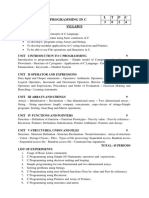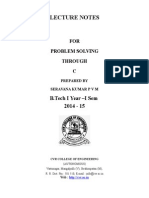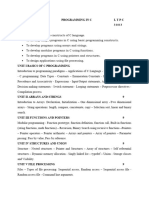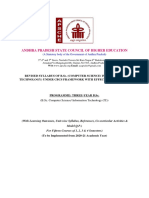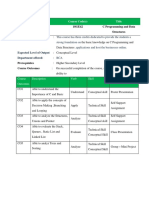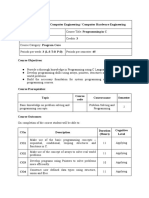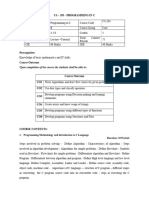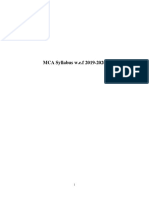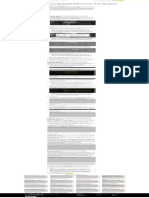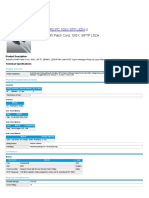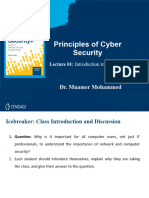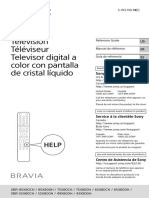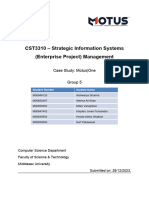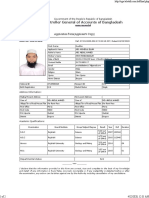L T P C
24ES1101 PROGRAMMING IN C
3 0 0 3
COURSE OBJECTIVE:
Recall fundamental programming paradigms and Recognize the syntax and structure of
C programs
Understand the principles behind arrays and strings and the functionalities of one-
dimensional and two-dimensional arrays.
Apply knowledge of functions, including function prototypes, definitions, and function
calls, to design.
Analyze complex data structures like structures, unions, and self-referential structures,
and their applications in programming
Evaluate the efficiency and effectiveness of various sorting and searching algorithms.
Design and implement programs that integrate multiple concepts, demonstrating
creativity and proficiency in solving real-world problems using C programming
techniques.
UNIT - I BASICS OF C PROGRAMMING 9
Introduction to programming paradigms – Algorithms – Flowchart - Structure of C
program - C programming: Data Types – Storage classes - Constants –
Enumeration Constants - Type Conversion Keywords – Operators: Precedence and
Associativity - Expressions - Input/Output statements, Format specifiers, Assignment
statements – Decision making statements - Switch statement – Break – Continue - Goto
statement - Looping statements – Pre-processor directives - Compilation process.
UNIT - II ARRAYS AND STRINGS 9
Introduction to Arrays: Declaration, Initialization – One dimensional array – Example
Program: Computing Mean, Median and Mode - Two dimensional arrays – Example
Program: Matrix Operations (Addition, Multiplication, Determinant and Transpose) -
String operations: length, compare, concatenate, copy, Reverse and Palindrome –
Selection sort, Insertion sort - linear and binary search
UNIT - III FUNCTIONS AND POINTERS 9
Introduction to functions: Function prototype, function definition, function call, Built-in
functions (string functions, math functions) – Recursion – Example Program: Computation
of Sine series, Scientific calculator using built-in functions, Binary Search using recursive
functions – Pointers – Pointer operators – Pointer arithmetic – Arrays and pointers
– Array of pointers – Example Program: Sorting of names – Parameter passing:
Pass by value, Pass by reference – Example Program: Swapping of two numbers and
changing the value of a variable using pass by reference.
UNIT - IV STRUCTURES AND UNION 9
Structure - Nested structures– Pointer and Structures– Array of structures – Example
Program using structures and pointers – Self-referentials structures – Dynamic memory
1
�allocation – Singly linked list– typedef and Union.
UNIT - V FILE PROCESSING 9
Files – Types of file processing: Sequential access, Random access – Sequential
access file - Example Program: Finding average of numbers stored in sequential
access file - Random access file - Example Program: Transaction processing using
random access files – Command line arguments.
TOTAL : 45 PERIODS
COURSE OUTCOME(S):
Upon completion of the course, students will be able to:
CO1 Remember fundamental concepts of C programming and the compilation process.
CO2 Explain the structure of C programs, algorithms, flowcharts, and the usage of arrays
and strings in programming.
CO3 Utilize functions, pointers, structures, and unions to solve programming problems,
including recursion and dynamic memory allocation.
CO4 Evaluate and compare different file processing techniques and their applications in
real-world scenarios.
CO5 Assess the efficiency and effectiveness of various sorting and searching algorithms.
CO6 Develop and implement programs that demonstrate proficiency in C programming
paradigms.
TEXT BOOKS:
1. Reema Thareja, ―Programming in C, Oxford University Press, Second Edition, 2016
2. Kernighan, B.W and Ritchie,D.M, The C Programming language, Second
Edition, Pearson Education, 2006.
REFERENCE BOOKS:
1. Paul Deitel and Harvey Deitel, C How to Program, Seventh edition, Pearson
Publication, 2015
2. Juneja, B. L and Anita Seth, Programming in C, CENGAGE Learning India pvt.
Ltd.,2011
3. Pradip Dey, Manas Ghosh, Fundamentals of Computing and Programming in C,
First Edition, Oxford University Press, 2009
4. Anita Goel and Ajay Mittal, Computer Fundamentals and Programming in C,
Dorling Kindersley (India) Pvt. Ltd., Pearson Education in South Asia, 2011
5. Byron S. Gottfried, "Schism‘s Outline of Theory and Problems of Programming with
C", McGraw-Hill Education, 1996
WEB REFERENCES:
1. https://github.com/tscheffl/ThinkC/blob/master/PDF/Think-C.pdf
2. https://freecomputerbooks.com/langCBooks.html
2
�ONLINE COURSES / RESOURCES:
1. https://www.programiz.com/c-programming
2. https://www.tutorialspoint.com/cprogramming/index.htm
3. https://www.javatpoint.com/c-programming-language-tutorial
4. https://www.geeksforgeeks.org/c-programming-language/
5. https://en.wikibooks.org/wiki/C_Programming
6. https://www.cprogramming.com/tutorial/c-tutorial.html?inl=hp
CO – PO MAPPING
PO1 PO2 PO3 PO4 PO5 PO6 PO7 PO8 PO9 PO10 PO11 PO12
CO1 2 1 1 1 1
CO2 2 1 1 1 2 1
CO3 3 2 2 1 3 1
CO4 3 2 2 1 3 1
CO5 2 1 1 1 2 1
CO6 2 1 1 1 2 1
Internal Assessment
End Semester Examinations
Assessment I (100 Marks) Assessment II (100 Marks)
Individual Individual
Assignment / Assignment /
Written Written
Case Study / Case Study / Written Examinations
Test Test
Seminar / Mini Seminar / Mini
Project Project
40 60 40 60 100
40% 60 %
3
�4
�5
�6

